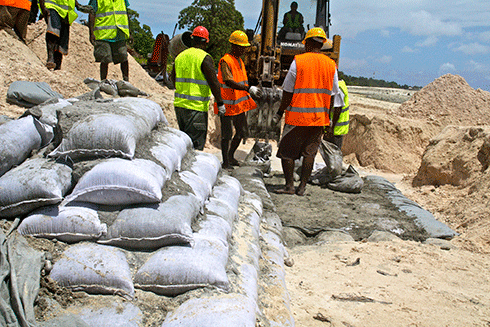
|
Published: 27 January 2015
Sea-level rise from 1990 to present higher than previously thought
The acceleration in global sea level from the 20th century to the last two decades has been significantly larger than scientists previously thought, according to a new study.

|
|
Building sea-walls, Tarawa, Kiribati: some low-lying islands are already experiencing the impact of rising sea levels. Credit: Lauren Day/World Bank/flickr under CC BY-NC-ND 2.0
|
The study, co-authored by Carling Hay, a post-doctoral fellow with Harvard University, and Eric Morrow, a recent PhD graduate, shows previous estimates of global sea-level rise for the period 1900–1990 had been over-estimated by as much as 30 per cent. The report, however, confirms previous estimates of sea-level change since 1990, suggesting that the rate of sea-level change is increasing more quickly than previously believed.
The new work is described in a paper published in Nature.
‘What this paper shows is that sea-level acceleration over the past century has been greater than had been estimated by others,’ Morrow said. ‘It's a larger problem than we initially thought.’
‘Scientists now believe that most of the world's ice sheets and mountain glaciers are melting in response to rising temperatures.’ Hay added. ‘Melting ice sheets cause global mean sea level to rise. Understanding this contribution is critical in a warming world.’
Previous estimates had placed sea-level rise at 1.5–1.8 millimetres annually over the 20th century. Hay and Morrow, however, suggest that from 1901 until 1990, the figure was closer to 1.2 millimetres per year. But scientists agree that global sea level has risen by about 3 millimetres annually since that time, so the new study points to a larger acceleration in global sea level.
‘Another concern with this is that many efforts to project sea-level change into the future use estimates of sea level over the time period from 1900 to 1990,’ Morrow said. ‘If we've been over-estimating the sea-level change during that period, it means that these models are not calibrated appropriately, and that calls into question the accuracy of projections out to the end of the 21st century.’
To obtain their improved estimate of 20th century global sea level, Hay and Morrow approached the challenge of estimating sea-level rise from a completely new perspective.
Typically, Hay said, estimates of sea-level rise are created by dividing the world's oceans into sub-regions, and gathering records from tide gauges – essentially yard-sticks used to measure ocean tides – from each area. Using records that contain the most complete data, researchers average them to create estimates of sea level for each region, then average those rates to create a global estimate.
‘But these simple averages aren't representative of a true global mean value’ Hay explained. ‘Tide gauges are located along coasts, therefore large areas of the ocean aren't being included in these estimates. And the records that do exist commonly have large gaps.
‘Part of the problem is related to the sparsity of these records, even along the coastlines,’ Morrow said. ‘It wasn't until the 1950s that there began to be more global coverage of these observations, and earlier estimates of global mean sea-level change across the 20th century were biased by that sparsity.
‘We know the sea level is changing for a variety of reasons,’ Hay said. ‘There are ongoing effects due to the last ice age, heating and expansion of the ocean due to global warming, changes in ocean circulation, and present-day melting of land-ice, all of which result in unique patterns of sea-level change. These processes combine to produce the observed global mean sea-level rise.’
The new estimates developed by Hay and Morrow grew out of a separate project aimed at modelling the physics that underpin sea-level ‘fingerprints’.
To their surprise, Hay said, it quickly became clear that previous estimates of sea-level rise over most of the 20th century were too high.
‘We expected that we would estimate the individual contributions, and that their sum would get us back to the 1.5–1.8 mm per year that other people had predicted,’ Hay said.
‘But the math doesn't work out that way. Unfortunately, our new lower rate of sea-level rise prior to 1990 means that the sea-level acceleration that resulted in higher rates over the last 20 years is really much larger than anyone thought.’
Source: EurekAlert!



